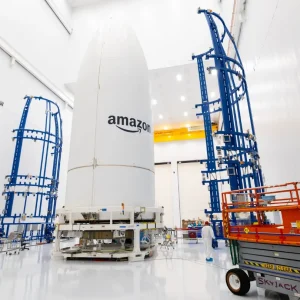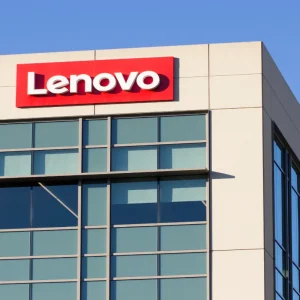Amazing multimedia chip, superfast 32-bit RISC, 64M-bit Flash memory, fast static lurking in NEC’s labs…
NEC Corp has been describing a glittering array of new semiconductor parts, headlined by what it describes as the world’s first video image processing chip that enables real-time recognition of moving images. This functionality is achieved by virtue of a processing speed of 3.84Giga-instructions per second. The prototype was fabricated in 0.55 micron BiCMOS aluminium process technology and the configuration includes 2M-bit of static RAM and 64 eight-bit processors. Ultra-high speed parallel data transfer circuits enable parallel access to image memory to achieve a 1.28G-bytes per second transfer rate. No indication of when it might be ready for marketing. The company also has a prototype low-power 64M-bit 3.3V Flash memory chip, where 8M-bit is the current highest capacity – in Intel Corp’s alternative technology. The part is fabricated in a 0.4 micron CMOS process and in the oooh aahh department, the chip stores the equivalent of the complete works of Shakespeare or 256 pages of Japanese newspaper text. NEC, like many other companies, sees Flash memory as important for portable data terminals, sub-notebook personal computers and Personal Digital Assistants. Again frustratingly few details – is it derived from the MIPS Technologies Inc R-series? – but NEC also announced a low-power 32-bit microprocessor with a clock speed of 500MHz. The part is fabricated to 0.4 design rules and an eight-stage pipeline architecture, as well as a high-speed cache memory with a read-in and record speed of 2nS. The company also claims the world’s fastest synchronous 16M-bit BiCMOS static RAM, which operates at 220MHz, implying a 4.5nS access time. Other features include wave pipeline technology and phased locked loop internal timing circuitry. NEC will also be sampling its Asynchronous Transfer Mode chip set, the NEASCOT, in April. The new chip set, with a voice and video data transfer rate of 156Mbps, is designed for use in multimedia local and wide area networks. The 0.8 micron uPD98401/402 chip set handles both transmit-receive data and does code generation and verification. Other functions include a wide 32Kb virtual connection for server connection, and a Utopia industry standard interface for easy connection to Sbus and Peripheral Component Interconnect buses. NEC plans to sell the chip set for use in local network equipment, and mass production will begin in October at a rate of 10,000 units per month.
…as it continues to hone its optical laser, switch skills
NEC Corp has also been busy in the optical labs, and has come up with a high-density optical disk technology that uses a red semiconductor laser instead of the conventional three-beam optical head, and a new recording method to increase eight-fold the amount of data that can be recorded on an optical disk. This recording method is known as the land-groove: the groove track is also used as a data track and both the land and groove areas have the same 0.6 micron width. With data compression techniques, the method can be used to record two hours of video data on an optical disk 5.1 in diameter. And NEC has developed an ultra-high speed optical switch that uses a laser diode and can handle a data pulse rate of 1Tbps. The switch uses the Push-pull Mach-Zehnder method, an original NEC invention. Using the switch, NEC says it will be possible to construct networks with 100 to 1,000 times the capacity of current networks, and sees it being used for transmitting multimedia applications. NEC says it will now work towards integrating the functions of the switch onto a single chip.
NEC to bundle expert system tool with Oracle7
NEC Corp and Oracle Corp have announced that they are to bundle NEC’s Caseholon software engineering tool with the Oracle7 relational database. The expert system tool is designed to examine the correctness of a knowledge base automatically, checking rules, and rule duplication and modifying and compressing the result. In Japan, the two companie
s will be using NEC’s distribution network and in the US, they will use Oracle’s marketing network. Sales are planned to begin in Japan in April and in the US toward the end of this year. The companies say they expect US sales of 2,000 of the combination bundles during the first year and 15,000 bundles during the second year. In Japan, they expect to achieve first year sales of 300 bundles, rising in the second year to sales of 2,000 bundles. Prices are not yet set. In Japan, NEC has also launched a Caseholon/DT desktop version of the expert system tool to be sold on its EWS 4800 series of Unix workstations. It was launched at the beginning of last month and is priced at $400, at which level NEC expects to sell 800 copies over the next two years.
NEC teams with Active Voice on voice mail product
Active Voice Corp, Seattle has joined with NEC Corp to launch a new NEC voice mail product. The VM-200, which the companies jointly designed and manufactured, will be marketed in Japan by NEC. It provides voice mail, automated attendant and audiotext, and includes Active Voice’s copyrighted 1-for-Yes, 2-for-No user interface, subscriber self-enrollment and facsimile detection, routing and notification. It also offers immediate reply, message redirection, operator assistance, message delivery to three different numbers, security codes and message cancellation. All system maintenance and installation is done over the telephone.
The succession comes as a surprise at NEC
The president of NEC Corp, Dr Sekimoto, surprised NEC-watchers by announcing his hand-picked successor, Dr Hisashi Kaneko, to be the company’s new president. He comes from a similar academic and telecommunications device background as Dr Sekimoto, and has made a career out of the international business of NEC, having been the chief executive of NEC America Inc for four years. He is currently a senior executive vice-president of NEC responsible for international operations. Dr Sekimoto, who moves to chairman of NEC, was expected to retire this year and is believed to have made his move early; however insiders believe he will still be a powerful force behind the throne, just as chairman Yamamoto is a force at Fujitsu Ltd after giving up his position in favour of president Sekizawa. NEC says it is in a stronger position this year than last, and expects a small profit, but hopes for a strong leadership from the new president, much needed in these interesting times when the computer market is still in recession, and may be disappointed say sources close to NEC.






